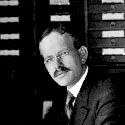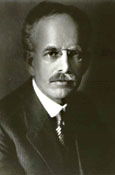
History
 |
The 150-Foot Solar Tower History |

Just five years after George Ellery Hale founded the Mount Wilson Solar Observatory with a grant from the Carnegie Institution of Washington, designs for a long-focal-length tower telescope were completed. In 1908, Hale discovered magnetic fields in sunspots (using the 60-foot solar tower built in 1907) by applying the principle of Zeeman splitting, where a spectral line will usually be split up into several components in the presence of a magnetic field.
 This was a discovery of great import. In order to study the Zeeman splitting of sunspots more precisely, Hale needed a telescope with a larger image scale and a spectrograph with a greater linear dispersion than the 60-foot could provide. Because of this, funds were provided by the Carnegie Institution of Washington, and in 1909, the construction of the 150-foot solar tower was begun.
This was a discovery of great import. In order to study the Zeeman splitting of sunspots more precisely, Hale needed a telescope with a larger image scale and a spectrograph with a greater linear dispersion than the 60-foot could provide. Because of this, funds were provided by the Carnegie Institution of Washington, and in 1909, the construction of the 150-foot solar tower was begun.
Unique to this solar telescope was the construction of two towers, one within the other. The inner tower consists of a metal framework supported at ground level on four concrete piers. Surrounding each beam of this inner tower are square, hollow steel beams mounted on separate massive piers. The inner tower supports the optics at the top, while the outer tower supports the structure and dome at top. Thus the optics are prevented from shaking in the wind, resulting in a very steady image at the base of the tower.
The tower structure was finished in 1910, but fabricating a 12-inch f/150 lens proved to be difficult. A triplet apochromat lens was ground by Brashear, but it suffered from astigmatism and chromatic aberration. In 1911, a 12-inch doublet achromat lens, also from Brashear, was installed in the tower. It, too, was unsatisfactory and was returned to the manufacturer for refiguring. After a second installation, the lens was used successfully until it was replaced by a Perkin-Elmer cemented triplet apochromat in 1971.

 With a grating obtained from Albert Michelson for the 75-foot spectrograph and a Littrow lens from John Brashear, the tower was completed in May 1912. Until the construction of the McMath-Pierce Solar Telescope at Kitt Peak, Arizona in 1962, the 150-foot solar tower had the longest focal length of any solar telescope in the world.
With a grating obtained from Albert Michelson for the 75-foot spectrograph and a Littrow lens from John Brashear, the tower was completed in May 1912. Until the construction of the McMath-Pierce Solar Telescope at Kitt Peak, Arizona in 1962, the 150-foot solar tower had the longest focal length of any solar telescope in the world.
Once the tower was built, solar observations began in earnest. Solar rotation studies were begun by Walter S. Adams in 1911 which produced very accurate spectroscopic rotation results and hinted at a velocity field that is now called supergranulation. In 1914, Hale discovered that polarities of sunspots in the north and south hemispheres of the sun reversed from cycle to cycle. Also, to keep track of sunspot polarities, daily sunspot drawings were begun in 1917. These drawings continue to this day.




After Hale's retirement in 1923, solar work was carried on by a number of solar astronomers and observers such as Ferdinand Ellerman, as Seth Nicholson, Edison Petit, and Charles St. John. Some of the progress would have to wait for technological advances (such as the photomultiplier tube) that would not come about until after World War II. However, a few special projects were initiated. Edison Petit contributed to the study of prominences. St. John persistently tried to determine the gravitational redshift of the Sun, using the 150-foot spectrograph. Long-range synoptic observing programs, such as the sunspot drawings and magnetic field measurements were continued throughout the twenties, thirties, and forties.
After the war, advances in electronics brought about rapid instrumental development in astronomy. In 1950, Dr. K. O. Kiepenheuer from the Fraunhofer Institute in West Germany spent six weeks at Mount Wilson. While here, he worked on a device to measure magnetic fields on the solar surface photo-electrically. He found weak fields surrounding sunspots.
Next, Dr. Horace W. Babcock developed the principle of the modern magnetograph and built the first magnetograph. An improved copy of this instrument was built and installed at the 150-foot tower in 1957. The beginning of the modern era at the 150-foot solar tower had begun. Fundamental discoveries followed each other rapidly during the fifties and sixties.
In September of 1961, Dr. Robert F. Howard joined the scientific staff of Mt. Wilson and took over as head of the solar program. Under his leadership, the magnetograph gradually improved. Daily synoptic full-disk magnetograms had been started in 1957. Digital data obtained at the solar tower (recorded on punched paper tape) were taken in 1962 and 1963. In 1964 a guider was added to the system. Soon after, a digitized signal was recorded on magnetic tape. Starting in 1966, daily scans were preserved on magnetic tape.
In 1983, a new exit slit assembly was installed that gave more accurate positioning and provided fiber-optic coupling to the photomultiplier tubes. In addition, a new grating, to replace one that had been submerged in water in the pit (due to a pump failure), was installed in 1982. These two improvements greatly enhanced the quality of the full-disk velocity data.
The science improved, but there was political instability. In 1984, the Carnegie Institution of Washington decided to close the Mt. Wilson Observatory. It looked as if the venerable 150-foot solar tower would not be able to point its mirrors to the Sun for much longer. However, Dr. Roger Ulrich, of the University of California at Los Angeles, expressed interest in using the tower for his own research in solar seismology. In late 1985, a "Memorandum of Understanding" was reached between the Carnegie Institution and UCLA, allowing research at the 150-foot solar tower to continue uninterrupted.
| Article by Pam Gilman. |